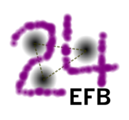Speaker
Description
The recent and old experiential data indicate that kaonic cluster $NN\bar K$ has deep quasi-bound state [1]. However, the theoretical models based on phenomenological $N\bar K$ potentials do not confirm it. Loosely bound state has been predicted by theoretical analysis of the JPARC
E15 experiment [2] using chiral potentials in the fixed center approximation.
In the framework of the Faddeev equations in configuration space the quasi-bound state of the kaonic system $NN{\bar K}$ is considered using both the isospin and ''isospinless'' particle representations.
Within the isospin formalism, the ''$ppK^-$ cluster'' is determined as $NN{\bar K}$$(s_{NN}=0)$ system.
We present the Faddeev equations in the "given charge" isospin basis, which allow us to show relation to the particle representation.
The alternative consideration of the kaonic clusters has been proposed by isospinless ''particle representation'' [3]. In our approach the system is described
as superposition of $ppK^{-}$ and $pn{K}^0$ states, which are possible due to a particle transition. We consider the equivalence of isospin and particle representations and show that the equivalence is possible only under condition that the probabilities to find the system in the $ppK^{-}$ or $pn{K}^0$ states are equal (strong coupling of the channels). Numerical calculations using phenomenological potentials will be presented. The relation of the isospinless model to the theory of two-level systems is addressed and discussed taking into account the possibilities of deep and shallow $NN{\bar K}(s_{NN}=0)$ quasi-bound states.
This work is supported by the National Science Foundation grant HRD-1345219 and NASA grant NNX09AV07A.
[1] T. Nagae, Nucl. Phys. A 954, 94 (2016)
[2] T. Sekihara, E. Oset, A. Ramos, PTEP 123D03 (2016)
[3] J. Revai, Phys. Rev. C 94, 054001 (2016)

